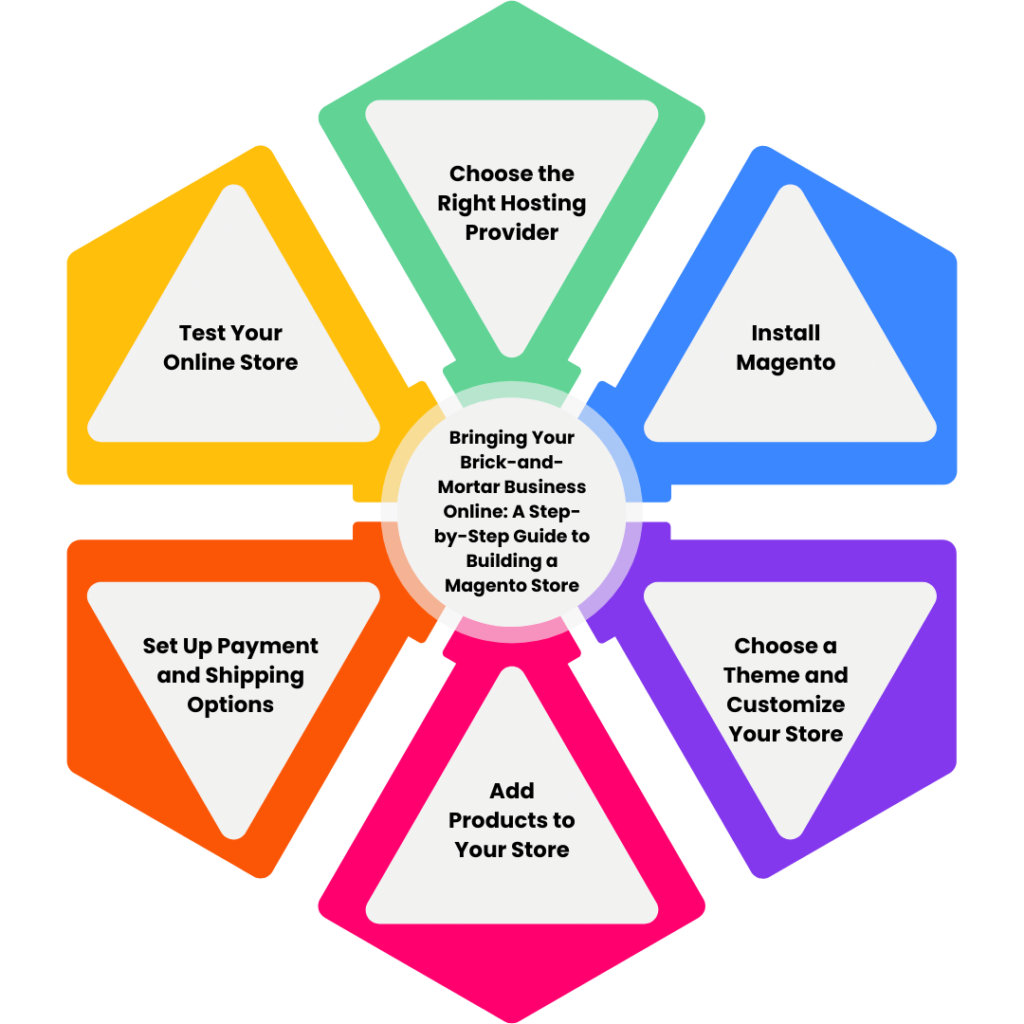Introduction
Building a Magento store is crucial in the digital era, as traditional brick-and-mortar establishments, although charming and authentic, are constrained by their physical presence. To flourish and expand their customer base, businesses must embrace the online realm. This is where Magento, an open-source e-commerce platform, proves invaluable, enabling us to take business online.
In this article, we’ll take you through the process of building a Magento store for your brick-and-mortar business. From choosing the right hosting provider to setting up your online store, we’ll cover everything you need to know to get started. Let’s dive in!
Step 1: Choose the Right Hosting Provider for Building Magento Store
The first step in building a Magento store for your brick-and-mortar business is to choose the right hosting provider. Your hosting provider is responsible for storing your website’s files and making them accessible on the internet. When it comes to Magento hosting, there are a few things to keep in mind:
- Look for a hosting provider that specializes in Magento hosting. They will have the necessary expertise and infrastructure to support your e-commerce store.
- Make sure your hosting provider offers a secure and reliable hosting environment. This is important to ensure the safety and stability of your online store.
- Consider the scalability of your hosting plan. As your business grows, you’ll need more resources to support your website. Make sure your hosting provider can accommodate your future needs.
Step 2: Install Magento to take your Business Online
Once you’ve chosen your hosting provider, it’s time to install Magento. Most hosting providers offer a one-click installation process, which makes it easy to set up your online store. Here’s how to install Magento:
- Log in to your hosting account and navigate to your control panel.
- Look for the option to install Magento and click on it.
- Follow the installation wizard and provide the necessary information, such as your store name and admin credentials.
- Once the installation is complete, you’ll be able to access your Magento dashboard.
Step 3: Building Magento Store -Choose a Theme and Customize Your Store
With Magento installed, it’s time to choose a theme for your online store. Your theme will determine the look and feel of your website, so it’s important to choose one that reflects your brand and appeals to your target audience. Here’s how to choose a theme for your Magento store:
- Browse through the Magento Marketplace to find a theme that meets your requirements. You can filter themes by category, price, and rating to narrow down your options.
- Once you’ve found a theme you like, purchase and download it.
- Install the theme by uploading the theme files to your Magento dashboard.
- Customize your theme by changing the colors, fonts, and layout to match your brand.
Step 4: Add Products to Your Store
With your theme customized, it’s time to start adding products to your online store. Here’s how to add products to Magento:
- Log in to your Magento dashboard and navigate to the “Products” tab.
- Click on “Add Product” to create a new product listing.
- Provide the necessary information, such as the product name, description, price, and images.
- Save the product listing and repeat the process for each product you want to add to your store.
Step 5: Set Up Payment and Shipping Options
With your products added to your online store, it’s time to set up payment and shipping options. This is an important step in the e-commerce process, as it ensures that your customers can easily make purchases and receive their products in a timely manner. Here’s how to set up payment and shipping options in Magento:
- Navigate to the “Stores” tab in your Magento dashboard and click on “Configuration.”
- Click on “Sales” and then “Payment Methods” to set up your payment options.
- Choose the payment methods you want to offer, such as credit card, PayPal, or bank transfer.
- Configure your payment options by providing the necessary information, such as your PayPal account details or your merchant ID.
- Next, navigate to the “Shipping Methods” tab to set up your shipping options.
- Choose the shipping methods you want to offer, such as standard shipping or expedited shipping.
- Configure your shipping options by providing the necessary information, such as your shipping rates and delivery times.
Step 6: Test Your Online Store While Building Magento Store
Before launching your online store, it’s important to test it to ensure that everything is working properly. This includes testing your website’s functionality, such as the shopping cart and checkout process, as well as your payment and shipping options. Here’s how to test your online store in Magento:
- Create a test order and go through the entire checkout process to ensure that everything is working properly.
- Test your payment options by making a small purchase using each of the payment methods you offer.
- Test your shipping options by making a small purchase and verifying that the product is delivered within the expected timeframe.
- Look for any issues or errors and address them before launching your online store.
FAQs
Q: Can I build a Magento store on my own, or do I need to hire a developer to take my Business online?
A: While it is possible to build a Magento store on your own, it can be a complex process that requires technical expertise. If you’re not comfortable with coding or web development, it’s recommended to hire a Magento developer to assist you with the process.
Q: Is Magento suitable for small businesses?
A: Yes, Magento is suitable for businesses of all sizes, including small businesses. It offers a range of features and customization options that can help small businesses build a robust online presence.
Q: How much does it cost for Building Magento Store?
A: The cost of building a Magento store can vary depending on several factors, such as the complexity of your website and the features you want to include. It’s recommended to get a quote from a Magento developer to get an accurate estimate of the cost.
Conclusion
Building a Magento store for your brick-and-mortar business can be a game-changer for your online presence and overall business growth. With the right hosting provider, theme, and customization options, you can create an e-commerce platform that reflects your brand and appeals to your target audience. By following these six steps, you can set up your Magento store and start selling your products online in no time. So, what are you waiting for? Start building your Magento store today and expand your reach to a global audience!
You should read this must know Magento SEO Best Practices to Improve Your Store’s Search Rankings.








